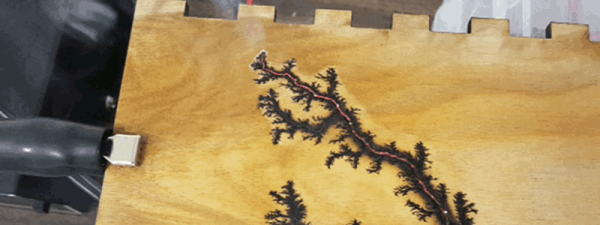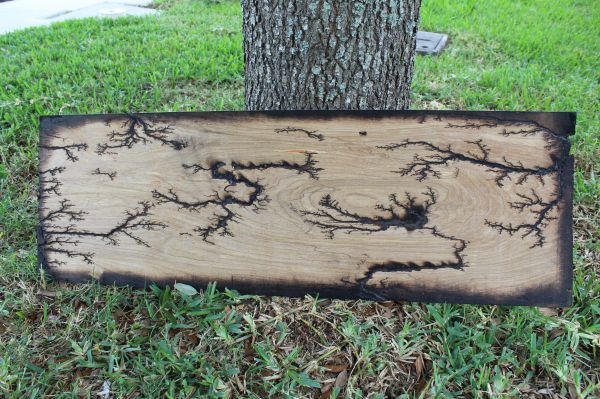We start this week with news from Mars, because, let’s face it, the news from this planet isn’t all that much fun lately. But a couple of milestones were reached on the Red Planet, the first being the arrival of Perseverance at the ancient river delta it was sent there to explore. The rover certainly took the scenic route to get there, having covered 10.6 km over the last 424 sols to move to a position only about 3.5 km straight-line distance from where it landed. Granted, a lot of that extra driving was in support of the unexpectedly successful Ingenuity demonstration, plus taking time for a lot of pit stops along the way at interesting features. But the rover is now in place to examine sedimentary rocks most likely to harbor the fossil remains of ancient aquatic life — as opposed to the mainly igneous rocks it has studied along the crater floor so far. We’re looking forward to seeing what happens.
Lichtenberg5 Articles
High-Voltage Fractals
Int 1777, Georg Lichtenberg found that discharging high voltage on an insulating surface covered with a powder, a fractal-like image appears, sometimes known as a lightning tree. Incidentally, this is a crude form of xerography, the principle that lets copiers and laser printers operate.
[PaulGetson] had a high voltage power source from his Jacob’s ladder experiments and decide to see if he could create Lichtenberg figures. Turns out, he could.
Making Lichtenberg Figures In Wood
Ever heard of a Lichtenberg Figure? It’s the branching electrical discharge you can sometimes see on an insulating material… That’s right — when the voltage is high enough — it’ll find a way. Using one of our favorite low-cost high voltage transformers from a microwave, [TheBackYardScientist] shows us how to make our own Lichtenberg Figures!
It’s actually pretty easy. All you need is an old microwave, some plywood, and water with baking soda mixed in. First, you’ll need to take the transformer out of the microwave — a simple hack we’ve covered many times before — you’ll need to wire it in a way that allows you to get a few thousand volts out of it.
Then by mixing baking soda in water, you can increase the conductivity — let the wood soak it up overnight, and now you’re ready to go! By attaching the leads to either side of the wood, it’s now conductive enough to allow the electricity to branch across the wood, burning awesome patterns as it goes — just take a look at the following video!
High Voltage, Wood And Resin Result In Fractal Art
Wood burning, which goes by pyrography when it’s feeling fancy, has been an art form for centuries. [PapaJ06] puts a new twist on it by using a microwave oven transformer to generate fractal patterns in wood. We’ve seen these Lichtenberg figures before, but generally as electric discharges in acrylic sheets or crystal balls using multi-mega-electron volt accelerators. [PapaJ06]’s technique is considerably simpler and well within the reach of most would-be fractal artists, relying as it does on a transformer salvaged from a $20 Craigslist microwave.
But the extra twist that really brings the wow factor to the fractal patterns burned into the wood is the addition of some phosphorescent resin to fill the valleys carved by the electric discharge. [PapaJ06] carefully prepares the wood, fills the burns with glow powder mixed with epoxy resin, and finishes with a little sanding, linseed oil and polyurethane. The contrast between the charred and intact wood, and the way the resin fills the voids really brings out the fractal nature of the Lichtenberg figures.
[PapaJ06] doesn’t really show us too much about his process, but luckily [TheBackyardScientist] recently posted a video of his process for riding the lightning. Check it out after the break.
Continue reading “High Voltage, Wood And Resin Result In Fractal Art”
Putting Lightning In Acrylic
Some folks at the i3Detroit hackerspace had an opportunity come up that would allow them to capture lightning in acrylic. They created a few Lichtenberg figures thanks to the help of a plastic tubing manufacturer, some lead sheet and a bunch of 1/2″ thick acrylic.
Lichtenberg figures are the 3D electrical trees found in paperweights the world over. They’re created through electrical discharge through an insulator, with lightning being the most impressive Lichtenberg figure anyone has ever seen. These figures can be formed in smaller objet d’art, the only necessity being a huge quantity of electrons pumped into the insulator.
This was found at Mercury Plastics’ Neo-Beam facility, a 5MeV electron accelerator that’s usually used to deliver energy for molecular cross linking in PEX tubing to enhance chemical resistance. For one day, some of the folks at i3Detroit were able to take over the line, shuffling a thousand or so acrylic parts through the machine to create Lichtenberg figures.
When the acrylic goes through the electron accelerator, they’re loaded up with a charge trapped inside. A quick mechanical shock discharges the acrylic, creating beautiful tree-like figures embedded in the plastic. There are a lot of pictures of the finished figures in a gallery, but if you want to see something really cool, a lead-shielded GoPro was also run through the electron accelerator. You can check out that video below.
















